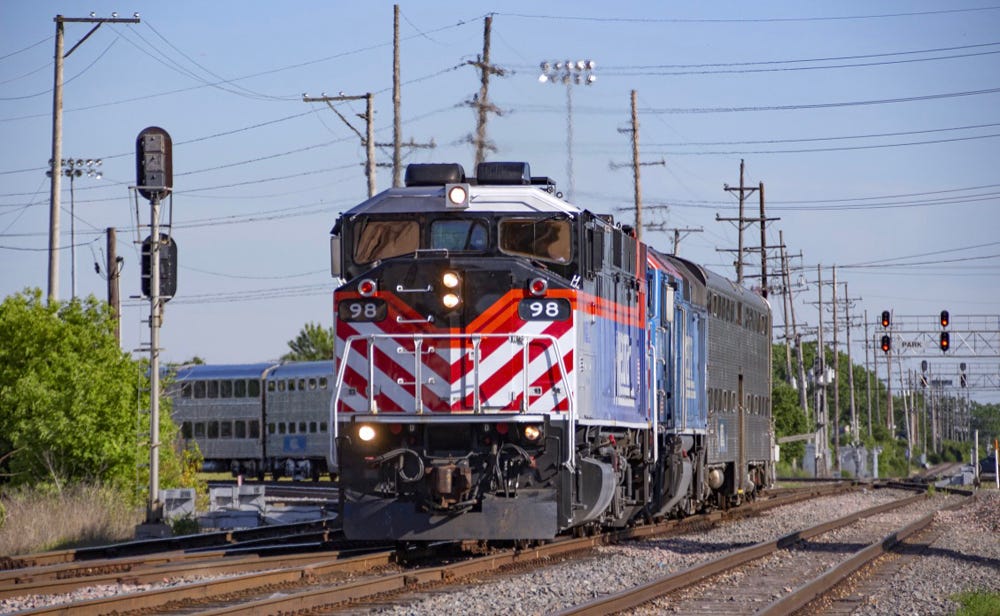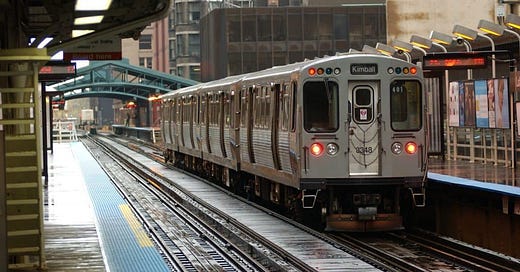This past weekend was Father’s Day, which meant another trip back to the far west suburbs (where I grew up and where my dad still lives). I’m not blessed with easy access to that part of the state from where my house is, either by train or by car, so it’s a real pain in the ass to go back there all the time. The door-to-door travel these days is three hours on a bad day, two and a half on a good one. First, I need to take a train from my neighborhood all the way down to the Loop (around 40 minutes), then walk a good bit to the train station, then get on another train (an hour and 20 minutes, typically). There’s also all the waiting.
If Google Maps tells me that a trip is going to take 40 minutes, I budget an hour (maybe even more than an hour) just in case there’s something wrong with the train timetables—which is more likely than not. If my train leaves Union Station at 10:40am, I have to be out of my house by 9:30am or I’m screwed, even though it shouldn’t take me 70 minutes to get there. For something like a train that has a set schedule, the CTA is extremely unpredictable.
Sunday morning, I left my house a few minutes past the 9:30 mark due to general lateness and my new habit of going out to parties on the weekend and sleeping terribly because of it. I thought to myself, “It’s fine, there’s a train coming soon and I should be able to make it to Union Station by 10:40.” But it wasn’t fine, the train I was counting on wasn’t actually coming and the next train to come was in thirteen minutes. So I sat there, waiting for the next one, being optimistic about some American public infrastructure. I got to the Loop and started walking, and I would have definitely been able to make it to the train by 10:40, just with no time for a Dunkin coffee—disappointing, but manageable.
But I had a feeling I was wrong. I open up the Ventra app to double check the timetables to see if I was right that the trains still left at the :40 of the hour on the weekends (like they did for at least the last decade), but they were not. They’ve updated their timetables to make the BNSF trains more frequent on the weekend, now running every hour with a couple expresses sprinkled in and the trains leave on the :33 of the hour instead. I wasn’t going to make it by five minutes. If the Red Line hadn’t been ghosting me I would have made it. Now I’ll have my Dunkin and have an hour to kill.
Call me crazy, but it doesn’t feel right that I need to shave off over a third of a workday and be really good at planning and coordinating things just to go back to the suburbs using regional transit. (I’m not even going to explain what the train ride home usually looks like, which usually involves going to a Brown Line stop that says the next train is coming in FORTY minutes and then walking down Dearborn in the rain hoping a bus will show up). Yet, this is the best we have, and things are more than likely going to get much worse.

If you didn’t hear the news from a couple of weeks ago, the Illinois Congress failed to pass anything in their budget bill about funding the Regional Transit Authority (Metra, Pace, and CTA) for the next year to fill the gap that federal Covid relief was funding for the past five years. Without the $770 million they need to keep service the way it’s currently going (which is still also a lot worse than pre-2020), it’s estimated that CTA train service will be cut by half, while about 60 percent of bus routes would also be eliminated—giving the third largest populated metro area (also very urbanly dense) with less bus service than Madison fucking Wisconsin.
With these projections, one in five Chicagoans would lose public transport access. Now, here’s the big question, where the fuck are people supposed to go and how the fuck do they get there? This is an old-timey built city designed by nerds who love good and effective public infrastructure. This is not an area that is so new that it could sprawl like Los Angeles could when the car companies came in to do their dirty work. There’s no room for expanding highways. Traffic is already so bad.
My job is telling us that a return to office is near. We’re going from two days to three, and slowly they’ll probably make us come in more. My job isn’t unique in this: all the jobs want people to use that sweet, sweet, office space. Public infrastructure is at an all-time low but we’re expected to operate like we did pre-Covid, when infrastructure was much better and there was funding for things and the government worked. If there are no trains to take people to their jobs but no place to park and not even enough computer chips to make more cars that are affordable for the people who now need cars to go to their jobs that pay them too little already, what is the end goal?
The State of Illinois provides the least money (percentage-wise) towards public transit than any other state with a major metropolitan area, like New York and Massachusetts. This is because Illinois famously never has money to do anything. Also, this is probably because the rest of Illinois hates the Chicagoland area and wants us all to die in a burning fire even though we’re the ones making all the money and paying all the extra taxes that ends up going to subsidize their farms that are not at all profitable. Why should anyone in Illinois pay taxes so that Chicago people can get to work on time? I don’t know, maybe if you left your town of 1,000 people you could learn why it’s important to fund public services.
One of the proposed ways to help local transit was to create the Metropolitan Mobility Authority (MMA), which would combine Metra, Pace, CTA, and the overarching RTA into one agency, which would promote collaboration over competition (like when former Mayor Lightfoot declined to increase South Side Metra service because it would “compete” with the CTA). This did not pass, which is disappointing but not surprising. Why should the state government have any part in helping a CITY’s transit system? I don’t know, because it’s a public GOOD and SERVICE?
They say, “What about the rest of the state?” and I say let’s make public transit better there, too! When I lived in the Quad Cities, I frequently used the bus system my freshman year when my friends and I didn’t have cars, but eventually stopped using it as the years went on (except for going to the bars, which was a whole other thing) because while “better” than a lot of bus systems, was still pretty unreliable. Why not open up the Amtrak to more towns? Or interstate busses with more stops, more service? The only thing to make transit better in other parts of the state is if those people in those towns USED the service.
Even in the city and the suburbs, ridership has been down a lot ever since the Covid-19 pandemic began. At first it was for safety reasons and everyone staying home, but the numbers never got better, partly because people aren’t commuting as much, but also because the product is just infinitely worse now. For a few years there weren’t enough employees to keep the same timetables, but instead of just making a new schedule that could handle the workforce it has, the CTA would just have a bunch of ghost buses and ghost trains—things that were scheduled but would never appear. That discouraged regular riders who needed to be at places on time, who probably now opted for rideshare or just getting their own car. With less riders, executives and government officials look at the rider numbers and go, “Well nobody even WANTS to ride the CTA anymore!” and then they don’t improve their service. And then when it comes down to do a major budget bill, funding for this crucial service doesn’t happen because it seems like nobody even wants it around anymore.
But that is fundamentally NOT true. Everyone I know in the city dreams for a day when we have 2019 CTA back. When we can reliably make it to a place across town at a specific time without planning an hour ahead, or take the bus without it actually just being a fun three-hour walk because no bus ever showed up. My friends in the suburbs like the Metra because driving in the city is scary and parking is a nightmare, but the city is where all the good concerts are. Many people moved to Chicago out of all of the other cities BECAUSE of the public transit that was offered. Not needing a car, to a lot of people, is a freedom that isn’t common in the United States.
When I lived in the suburbs of Paris for a short while (brag, it was seven years ago now), transit was not perfect, but it was better. Everyone used it—students, foreigners, rich people, poor people, city folk, suburbanites. Unless there was a strike going on (which, there were plenty of), the trains were still the best way to get to the airport. I’m not even going to get into high-speed rail here (that is too advanced of a topic). In the United States, though, nobody uses it except people who are legally not allowed to get their license, people who cannot afford a car and/or insurance, people who are afraid of driving, or public transit nerds who are on the NUMTOT Facebook page. If more people ride it, then more money will go into it and then it will be better and then society will be perfect. For now, we’re at the mercy of people downstate who like burning fuel on pickup trucks (sorry to those downstate who aren’t like this, I’m generalizing).
There was another idea floating around to get some more revenue for the RTA to get a few more dollars: another tax. People in Illinois and especially Chicago hate taxes because there’s taxes on everything. I remember changing my credit card’s billing address from my parents’ place in the suburbs to my new place in the city and my Netflix went up $1.50 for an “entertainment tax” and I’ll admit I was a little bit mad. This city and state is hemorrhaging money and I’m not a money expert and don’t know what the solution is but I think I also still believe government employees deserve pensions. Anyways. They proposed an extra $1.50 tax on food delivery app services to cover some of the cost and Big Uber sent a push notification to everyone saying that this new law would ruin America and that we should tell our lawmakers to stop the tax on the burrito taxi that costs $10 million per order. If there’s no public transit, overpriced rideshare apps can fill in the need—that’s the goal, at least. I hate it here.
Not all hope is lost. Organizations like Better Streets Chicago are still working on fighting the fight, and there’s a little chance that some big politics is going to happen in the next year that will save public transit in the midnight hour (JB Pritzker, where HAVE you been? Brandon Johnson, you too!). Other states have dealt with similar things and have ended up okay, but Illinois can disappoint hard. If it doesn’t work out, you can catch me walking 6 miles to work every day, I guess.




